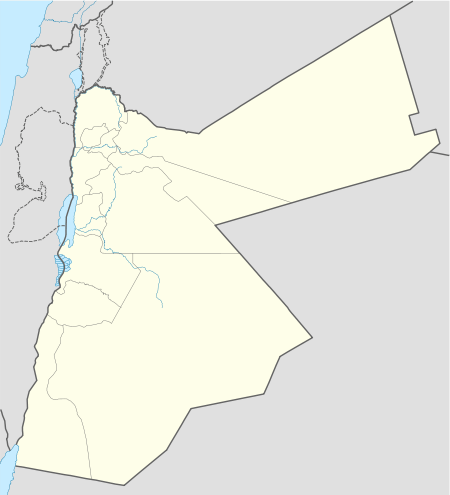Iraq Al-Amir
| `Iraq al Amir | |
|---|---|
 `Iraq al Amir Location in Jordan | |
| Coordinates: 31°55′N 35°45′E / 31.917°N 35.750°ECoordinates: 31°55′N 35°45′E / 31.917°N 35.750°E | |
| Country |
|
| Governorate | Amman Governorate |
| Time zone | UTC + 2 |
Iraq al-Amir or Araq el-Amir (Arabic:عراق الأمير - literally, "Caves of The Prince"), is the name shared by a town and nearby caves, within the municipality of Amman in the Jordan Valley. Located about 15 km southwest of the town of Wadi as-Seer, it has a population of about 6000 people, mostly members of the tribe of Abbadi. During the Greek Macedonian occupation, Iraq al -Amir was known under the Greek name Tyros. Ptolemy Philadelpus built the city, transferring population from Tyrus of Phoinicia. It is located on the hills with high and medium altitude, the area has many springs, and is famous for its olive trees, in addition to other forest trees. About 0.5 km south of the town is located the so-called Al-Iraq historical site, marked by the partially restored palace (known colloquially as Qasr Al-Abd, (literally, "Palace of the Servant") perhaps an ironic reference to the name etched in the caves nearby, believed to be the name of the owner of said estate. See link below for more information) which was built during the Hellenistic period, around the 3rd century BC, and reused under Byzantine rule before being destroyed by an earthquake. There are many caves in the hills which were inhabited during the Copper Age.
Bibliography
- Will, E. and Larché, F., ‘Iraq al Amir, le Château du Tobiade Hyrcan. 2 vols (Paris: P. Geuthner, 1991) (BAH 132).
- Larché, F., ‘Iraq al-Amir, le Château du Tobiade Hyrcan. Vol. II: Restitution et Reconstruction. 2 vols (Beirut: IFPO, 2005) (BAH 172).
- Rosenberg, Stephen Gabriel, Airaq al-Amir, The Architecture of the Tobiads (Oxford: Hadrian Books, 2006) (BAR International Series 1544).
- Rosenberg, Stephen, "Felicien de Saulcy and the Rediscovery of Tyros in Jordan," Palestine Exploration Quarterly, 138,1 (2006), 35-41.
- 'Iraq al-Amir, guide historique et archéologique du domaine des Tobiades. Beyrouth, Guides archéologiques de l’Ifpo, 2010.